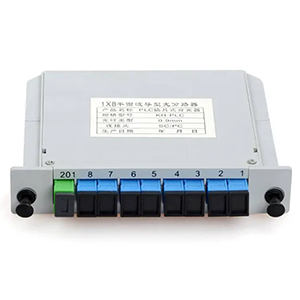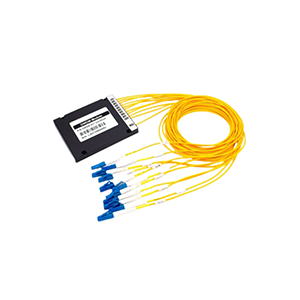PON undoubtedly plays an important role in fiber-to-the-home (FTTH). This article will explore the unique advantages of WDM-PON technology. We will first define the working principle of PON (Passive Optical Network) and briefly introduce common PON technologies such as TDM-PON and GPON. Next, we will explain the working principle of WDM-PON (Wavelength Division Multiplexing PON) and explain its unique advantages compared with other PON technologies.
We will analyze the advantages of WDM-PON in terms of optical wavelength utilization, bandwidth, security, etc., and explain its flexibility and scalability. In addition, we will describe the key issues that need to be solved in the implementation of WDM-PON and introduce innovative solutions and latest developments to solve these challenges. Finally, we will explain the advantages of WDM-PON deployment in FTTH networks and explain how it meets the needs of broadband access and service convergence.
Review of PON Technology Basics
Let me review the basic working principles of PON (Passive Optical Network) technology and some common PON technologies for you in detail.
Working principle of PON technology:
PON is an access technology based on optical fiber network, which adopts passive optical network topology and mainly includes the following components:
(1) OLT (Optical Line Terminal):
- Located in the network center, responsible for providing services to end users.
(2) ONT/ONU (Optical Network Terminal/Unit):
- Installed at the user site, receiving and sending data in the PON network.
(3) Optical Splitter:
- It is a key passive component in the PON network architecture, used to distribute optical signals to multiple users.
The working principle of PON is: OLT broadcasts downstream data to the optical splitter, and the splitter distributes it to each ONT/ONU; while the upstream data is aggregated by ONT/ONU to OLT. This single-fiber bidirectional PON network structure can achieve high-bandwidth access to fiber-to-the-home.
Common PON technologies:
(1) TDM-PON (Time Division Multiplexed PON):
- Time division multiplexing is used to achieve multi-user sharing on a single optical fiber.
- Representative technologies include EPON (Ethernet PON) and GPON (Gigabit Ethernet PON).
(2) GPON (Gigabit PON):
- It is a standardized PON technology established by ITU-T.
- It can support up to 2.5Gbps downstream bandwidth and 1.25Gbps upstream bandwidth.
(3) TWDM-PON (Time and Wavelength Division Multiplexed PON):
- Combining time division multiplexing and wavelength multiplexing technology, it further improves the bandwidth of the PON network.
- It is one of the development trends of PON networks in the future.
In general, PON technology uses passive optical splitters to achieve multi-user sharing of optical fibers, which is one of the effective access methods for fiber-to-the-home. Different PON technologies have their own characteristics in terms of bandwidth, coverage distance, etc., and can be selected according to actual needs.
Unique Technical Features of WDM-PON
Let me introduce you in detail the unique technical features of WDM-PON (Wavelength Division Multiplexed PON) in terms of optical wavelength utilization, bandwidth, security, etc., as well as its flexibility and scalability.
Technical advantages of WDM-PON:
(1) Optical wavelength utilization:
- WDM-PON uses wavelength division multiplexing technology, which can simultaneously transmit multiple optical signals of different wavelengths on a single optical fiber.
- This greatly improves the wavelength utilization efficiency of optical fibers, which has obvious advantages over time division multiplexing PON technology.
(2) Bandwidth expansion:
- Each user can be assigned a dedicated upstream and downstream wavelength, thereby realizing independent high-bandwidth services.
- Without being constrained by the time-division multiplexing scheme of shared bandwidth, it can better meet users’ demand for high bandwidth.
(3) Improved security:
- Since each user uses an independent wavelength, data access between users can be effectively isolated.
- The network security is greatly enhanced, and the risk of eavesdropping and data leakage is reduced.
(4) Flexibility and scalability:
- WDM-PON has strong flexibility and can dynamically allocate wavelength resources according to demand.
- By increasing the number of optical wavelengths, the overall bandwidth and user capacity of the network can be easily expanded.
WDM-PON’s scalability is reflected in:
(1) User expansion:
- Simply increase the number of optical transmitters in the OLT and allocate dedicated wavelengths for new users.
- No need to massively transform the existing passive optical splitters or optical cable networks.
(2) Bandwidth expansion:
- By adding new wavelength channels, the total bandwidth of WDM-PON can be simply expanded.
- This method is more flexible and efficient, and does not require changing the existing network structure.
(3) Service type expansion:
- WDM-PON supports the coexistence of multiple service types (such as IPTV, VoIP, high-speed Internet access, etc.).
- By allocating dedicated wavelengths, differentiated services can be provided for different businesses.
In short, WDM-PON has become an important direction for the development of future PON networks due to its advantages such as excellent wavelength utilization, high bandwidth, security, as well as good flexibility and scalability. This advanced PON technology can better meet the needs of future broadband access networks.
Technical challenges of WDM-PON deployment
Let me analyze in detail the key technical challenges that need to be solved when deploying WDM-PON networks, as well as the corresponding innovative solutions and latest progress.
Technical challenges in WDM-PON deployment:
(1) Wavelength stability:
- Since WDM-PON requires the use of multiple precise wavelength channels, the wavelength stability of the light source is very high.
- Temperature, aging and other factors can cause wavelength drift, and effective wavelength control measures need to be taken.
(2) Low-cost optical devices:
- WDM-PON requires a large number of wavelength-selective optical devices, such as filters and optical transmitters.
- The relatively high cost of these components limits the large-scale deployment of WDM-PON.
(3) Passive optical splitter compatibility:
- WDM-PON needs to be compatible with existing passive optical splitter equipment and reuse existing fiber optic infrastructure.
- This requires the design of WDM-PON to match the characteristics of the splitter.
(4) Dynamic bandwidth allocation:
- Since each user has an independent wavelength channel, a complex dynamic bandwidth allocation algorithm is required.
- To ensure efficient use of network resources and meet the business needs of different users.
Innovative solutions and progress to address these challenges:
(1) Low-cost narrowband lasers:
- Develop low-cost narrowband laser technologies based on VCSEL, DFB, etc. to reduce the cost of optical transmitters.
- For example, use low-cost tunable lasers or external modulator solutions.
(2) New passive optical splitters:
- Develop new passive wavelength division splitters compatible with WDM-PON to improve optical splitting efficiency.
- For example, use new material technologies such as thin film filters to achieve wavelength selective splitting.
(3) Intelligent bandwidth management:
- Apply machine learning, SDN and other technologies to achieve intelligent dynamic bandwidth allocation in WDM-PON networks.
- Flexible and efficient bandwidth scheduling based on real-time business needs of users.
(4) Integrated WDM-PON equipment:
- Promote the integration of key WDM-PON components to improve reliability and reduce costs.
- Such as PIC technology that integrates transmitters, filters, etc. on the same chip.
In short, through continuous technological innovation and optimization, the deployment cost and complexity of WDM-PON are being significantly improved, laying the foundation for future large-scale applications.
Application of WDM-PON in FTTH
Let me introduce you in detail the application advantages of WDM-PON technology in FTTH (fiber to the home) networks, and how to meet the needs of broadband access and business convergence.
WDM-PON deployment advantages in FTTH networks:
(1) Bandwidth expansion capability:
- WDM-PON can provide each user with an independent high-bandwidth communication channel to meet future bandwidth needs.
- By increasing the number of wavelengths, the total network bandwidth can be easily expanded without changing the existing network structure.
(2) Flexibility and scalability:
- WDM-PON has good flexibility and can dynamically allocate wavelength resources according to user needs.
- When a new user accesses, only a dedicated wavelength needs to be allocated, without the need to massively transform the existing passive optical splitter.
(3) Improve network security:
- Each user has an independent wavelength channel, which can effectively isolate data access between users.
- Reduces the risk of eavesdropping and data leakage, and improves the security of FTTH networks.
(4) Business support capabilities:
- WDM-PON supports the coexistence of multiple business types, such as IPTV, VoIP, and high-speed Internet access.
- By allocating dedicated wavelengths, it can provide differentiated service quality assurance for different services.
WDM-PON meets the needs of broadband access and business integration:
(1) Broadband access requirements:
- With the growing demand for high-definition video, cloud computing and other services, WDM-PON can meet these needs with its powerful bandwidth expansion capabilities.
- By flexibly allocating dedicated wavelength channels, each user can be provided with exclusive high-bandwidth communication services.
(2) Service integration requirements:
- WDM-PON supports multiple service types to share transmission resources in the same optical fiber network.
- By allocating different wavelength channels, it can provide differentiated service quality guarantees for different services and achieve service integration.
- This is conducive to operators providing a richer service portfolio to meet the diverse needs of users.
In summary, WDM-PON technology has shown many advantages in FTTH networks, which can effectively meet the needs of future broadband access and service integration, and become one of the important technical directions for the development of FTTH networks. With the continuous improvement of cost and integration, WDM-PON will surely be more widely used in the FTTH field.
Summary
WDM-PON is undoubtedly the key to building a high-performance FTTH network. Our company has long been focusing on the research and development and application of optical communication technology and has rich industry experience. Our WDM-PON system products are at the industry-leading level in terms of optical performance and reliability, and can meet your demanding needs for broadband access and business integration.
Whether you need to deploy WDM-PON in a metropolitan area network or access network, or customize it for a specific application scenario, we can provide you with a one-stop solution. At the same time, our professional team will provide you with a full range of technical support, including solution design, on-site guidance, and daily maintenance suggestions. Contact us now to learn more about WDM-PON technology.
WDM-PON FAQ
WDM-PON is a fiber optic network architecture that combines the principles of wavelength-division multiplexing (WDM) and passive optical networking (PON) to increase the capacity and efficiency of fiber-to-the-home (FTTH) deployments.
Unlike traditional TDM-PON (Time Division Multiplexed PON) systems that use a single wavelength, WDM-PON utilizes multiple wavelengths to provide dedicated capacity to individual subscribers.
The main advantages of WDM-PON include higher aggregate bandwidth, improved security, and the ability to offer customized services to each subscriber.
WDM-PON typically uses the C-band (1530-1565 nm) and L-band (1565-1625 nm) wavelength ranges, with each subscriber assigned a dedicated wavelength.
Downstream traffic is typically broadcast to all subscribers, while upstream traffic is carried on dedicated wavelengths assigned to each individual subscriber.
Essential components include the optical line terminal (OLT) at the service provider’s central office, wavelength-selective optical splitters, and the customer-premises equipment (CPE) at the subscriber’s location.
Potential challenges include the increased complexity of wavelength management, the need for strict wavelength alignment, and the higher initial cost compared to traditional PON technologies.
WDM-PON’s dedicated wavelength per subscriber enables the provision of high-bandwidth services, such as ultra-high-definition video, cloud computing, and business-class internet access.
Ongoing developments include the use of tunable transceivers, the integration of WDM-PON with other networking technologies, and the exploration of higher-density wavelength channel plans.
WDM-PON is primarily deployed in fiber-to-the-home (FTTH) and fiber-to-the-building (FTTB) applications, as well as in enterprise and business-oriented fiber optic networks.



